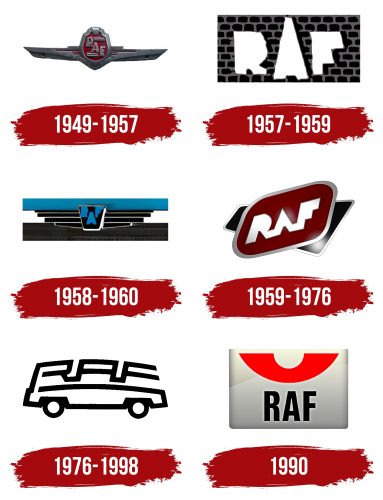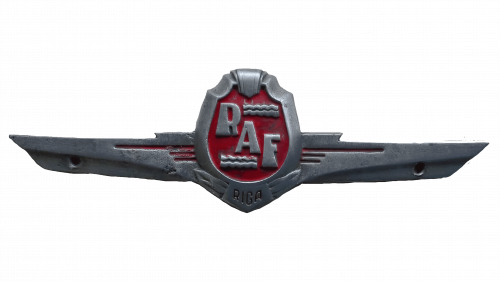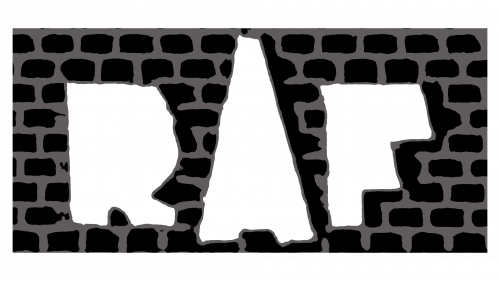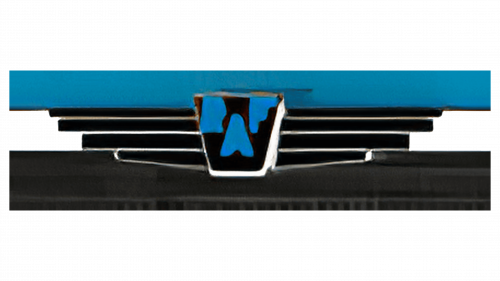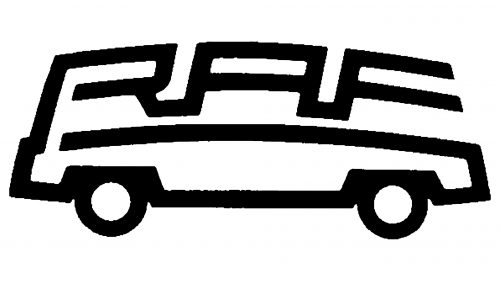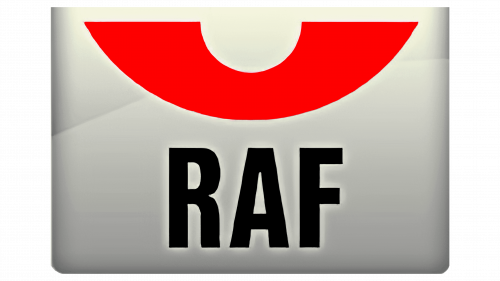The RAF logo, which often reflects the car’s shape, reflects the entire history of a once-popular vehicle manufacturer. The connection between reality and artistry resulted in an accurate emblem highlighting the company’s range.
RAF: Brand overview
RAF (Rīgas Autobusu Fabrika—Riga Bus Factory) weaved a distinctive automotive history from 1949 to 1998, becoming a vital producer of minibusses and specialized vehicles in the Soviet Union and later in Latvia.
In 1949, the brand was born in Riga, the heart of the Latvian SSR. Initially, the factory operated as a repair hub for buses and trucks, focusing on maintaining and refurbishing existing vehicles rather than producing new ones.
The 1950s ushered in a transformative era for the brand. The factory rolled out its first minibusses based on the GAZ-51 chassis, dubbed the RAF-251 models. These pioneering vehicles laid the groundwork for the brand’s future in vehicle production.
A landmark achievement came in 1955 when the brand introduced its first self-developed minibus, the RAF-10. This 9-seater vehicle, crafted using components from the GAZ-M20 Pobeda, marked a significant leap in the brand’s manufacturing capabilities.
By 1958, the RAF-977 “Latvija” entered production, destined to become an iconic minibus in the USSR. Widely used as route taxis, ambulances, and for various other purposes, the RAF-977 remained in production until 1976, cementing its legacy.
The 1960s saw the brand expanding its production prowess and exporting vehicles to other socialist countries, bolstering its international presence.
In 1976, the brand unveiled the RAF-2203 “Latvija,” the most mass-produced and recognizable model in the factory’s history. This minibus, a staple across the Soviet Union, remained in production until the factory’s closure.
The 1980s marked the zenith of the brand’s production, with up to 17,000 minibusses rolling out annually. The factory was a major employer in Riga and integral to the Soviet automotive industry.
The collapse of the Soviet Union in 1991 introduced formidable economic challenges for the brand. Disrupted economic ties with former Soviet republics led to a sharp decline in demand for its vehicles.
From 1992 to 1997, the brand strived to navigate the new market conditions. The factory developed new models like the RAF-3311 cargo van and updated versions of the RAF-2203. However, efforts to establish collaborations with foreign manufacturers did not secure long-term success.
Despite these endeavors, the brand could not surmount its financial struggles or the rising competition from foreign manufacturers. In 1998, the factory declared bankruptcy and ceased operations.
Throughout its nearly 50-year journey, the brand produced hundreds of thousands of minibusses, becoming integral to the urban fabric of the USSR and Eastern Europe. These vehicles served as route taxis, ambulances, police vehicles, and more.
The brand was pivotal in Latvia’s industrial history and a testament to Soviet automotive engineering. Even after its closure, the brand’s legacy and its vehicles continue to captivate enthusiasts and collectors of vintage cars.
Today, the brand’s minibusses, especially the RAF-2203 “Latvija,” are cherished by collectors and restorers. They serve as tangible reminders of a significant era in Eastern European automotive history and the technological triumphs of their time.
Meaning and History
What is RAF?
It is a Latvian automobile and bus manufacturer known for producing various vehicles, including minibusses, vans, and commercial vehicles. The company gained prominence for its versatile and reliable vehicles, which are widely used for public transportation, commercial purposes, and by various government agencies. Vehicles were recognized for their practicality and robustness, serving a critical role in transportation across the region.
1949 – 1957
The logo is shaped like a chest badge, resembling an achievement award. It symbolizes the company’s recognition of those who choose its products, showcasing impeccable taste to the world. The technical aspects are well thought out, with the internal structure of the vehicle harmoniously complemented by visual elements that create a specific brand image. Among the most significant details are:
- The crest of the minibus manufacturing plant (located in the center)
- The inscription RAF (an abbreviation formed from the full name Rīgas Autobusu Fabrika)
- Wings (there are two, positioned on the right and left of the central element)
The center of the crest features text and waves, indicating proximity to the Baltic Sea and the Daugava River, as Riga, where the plant operated, is located on its banks. Thus, the emblem includes two waves harmoniously complementing the enterprise’s name. The city name is inscribed at the bottom on laurel wreaths, using block letters with thin strokes, adding sophistication to the emblem.
The wings consist of three stripes on each side. Although they add weight to the emblem, it still appears light and airy. This combination relies on contrast, attracting consumers’ attention as they wonder why wings are depicted here. The wings hold significant importance for the company, symbolizing the high speed of the vehicles, as if they fly on the roads like wings.
The inscription is designed in a massive font with an elegant style: expansions replace serifs, and there is a harmonious combination of wide and narrow strokes. This adds dynamics to the text, making it livelier and more appealing to potential customers, attracting attention, and encouraging them to read the name closely.
1957 – 1959
The era of abbreviations has arrived, so it dominates the RAF logo, pushing other elements out of view. The shape has also significantly transformed: the elegant details have been replaced by a background resembling a brick wall, introducing shadows cast by large glyphs on the rectangular emblem. This wall has weighed down the sign and created confusion because, according to the concept, this is the logo of a minibus manufacturer. However, one only sees bricks, as the main focus has shifted to them, making it seem like the emblem belongs to a brick factory.
The inscription hints at the automotive theme in white glyphs with solid fills, lacking gaps, bars, or legs – just outlines. The abbreviation is arranged horizontally, but the letters vary in size. The tallest letter is “A,” positioned in the center, touching the top. Through this design, the company aimed to:
- Present itself as a giant in the field of medium-tonnage vehicle production
- Emphasize its importance in the specialized market
- Demonstrate its high popularity among the population
The improvised wall background is black, the brick outlines are beige, and the letters are white. Together, they form a subtle color palette – non-aggressive, practical, and fitting for the industry the brand represents. Translating from graphic language to human language, it becomes clear that the emblem suggests practical machinery for practical people.
1958 – 1960
The return to elements resembling wings occurred due to their similarity to the radiator grille on car hoods. Designers noticed this feature and proposed a modern logo for the minibus manufacturer, where flight is associated with swift driving and transport machinery. Through meticulous work, a unique emblem emerged, where this similarity is taken to the extreme, making it unclear whether it depicts outspread wings or a radiator grille. They are perfectly balanced, highlighting the most important aspect—swift speed.
The crest was transformed into a modernist shield with a trapezoidal shape. It is now black with blue letters on it. This combination represents reliability, constancy, and progress. Blue signifies growth and upward aspiration, while black symbolizes practicality and the earth. Together, they symbolize rapid movement on the roads.
The abbreviation has been reformatted: the letters changed position and became symmetrical. “A” has been moved down, and the adjacent “R” and “F” stand like guardians, extending on either side of it. The glyphs still have a solid fill, with no internal gaps or divisions – only the external contours are visible. For an automotive company, this means a lot, as its concept suggests a universal interpretation of the emblem for all models, regardless of their application.
The aim to unify different types of minibusses under a common logo stems from the fact that the company produces transport vehicles that have performed equally well in various fields—from the medical sector, where they serve as ambulances, to the courier sector, where they deliver goods.
1959 – 1976
The rearrangement of elements successfully impacted the RAF logo with its many smooth lines and rounded shapes. These usually evoke positive emotions in consumers, as they do not associate with rigidity and sharpness. On the contrary, soft strokes create a sense of a beneficial purchase, a friendly mood, and a pleasant atmosphere, which is crucial for the minibus manufacturer to elevate its status and enhance its image. The emblem’s modernization mainly involved three features:
- Introduction of a diamond shape with rounded corners
- Moving the trapezoid (crest) to the background
- Aligning the abbreviation in a single line
The inscription now looks very presentable. It has become understandable because the letters are arranged in rows, not scattered randomly. The line ascends, indicating an optimistic view of the future through the lens of previously established plans. The massive letters convey an atmosphere of confidence. This feeling arises when looking at the connected glyphs: they flow smoothly into one another.
The only thing that remained the same was the absence of internal gaps and bars in the letters, maintaining a solid fill and clear contours. For better readability, the inscription is painted white, clearly visible against the dark burgundy background. The trapezoid in the background is black. These colors blend well, forming a classic combination, suggesting the company’s close connection to its roots and mastery of traditional technologies for the successful development of the brand.
1976 – 1998
RAF chose a logo featuring a stylized car to demonstrate its connection to the automotive industry. It consists of several elements that, at first glance, seem incompatible:
- The bottom of the emblem resembles the classic wheelbase of a passenger vehicle (side view).
- The upper part represents the manufacturer’s name, arranged in the shape of the car’s body.
The abbreviation is so curved that it is barely recognizable in the rectangular letters, which resemble geometric shapes more than conventional glyphs. The inscription is bold and cohesive, with distinct internal gaps. This reflects the manufacturer’s commitment to transparency, customer orientation, and friendliness. Open spaces also indicate an attempt to systematize processes, bring them under control, and simplify and ease them, requiring high professionalism and the implementation of innovations.
The car’s contours are precisely retained, although it is drawn with a single continuous line that curves, forming the hood, the name, the wheels, and the rear windshield. Overall, the emblem is thematic, corresponding to the products manufactured under this brand.
1990
The RAF logo has acquired entirely different features – modernist, confident, and progressive. This reflects the company’s desire to become more contemporary and appeal to consumers who choose advanced technology that meets the demands of the times. To fully embody this concept, designers based the logo on a chrome rectangle with a gray gradient, transitioning from white at the top to dark at the edges.
This zoning created a three-dimensional emblem where each element stands out individually. The background impresses with the natural texture of a matte-silver surface. It gives the impression that this is not just a logo but an essential machine component—a crucial part without which the equipment would not function.
The manufacturer’s name, designed in a simple style, is in the center of the chrome plate. The letters are tall, bold, and sans-serif. The absence of serifs indicates a commitment to collaboration, mutually beneficial deals, and customer loyalty. Smooth strokes suggest easy maintenance and wide accessibility of the equipment. Above the abbreviation is a large red arc. It perfectly balances the black glyphs, adding brightness and cheerfulness to the emblem.

